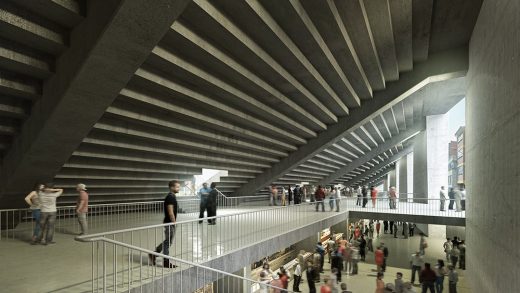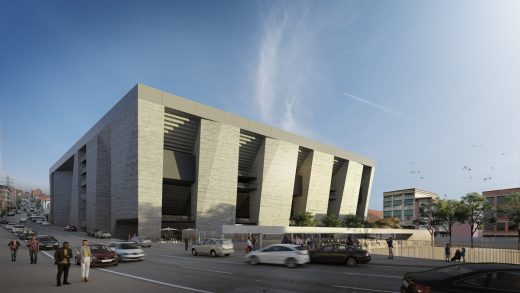Club Bolívar La Paz, Bolivia Stadium Building Images, South American Architecture Design
Club Bolívar Stadium, La Paz, Bolivia
2 December 2022
La Paz, Bolivia: Construction begins on the Bolívar stadium designed by L35 Architects
Design: L35 Architecture
Location: La Paz, Bolivia
images © L35, courtesy of architects practice
Club Bolívar La Paz, Bolivia Stadium Building
The same architecture practice is carrying out the remodeling of Real Madrid’s emblematic Santiago Bernabéu stadium.
The new home of Club Bolívar stands on the remains of the previous stadium, with a monumental volume, which will be a landmark in the city of La Paz, although permeable, open and connected to its surroundings.
L35 has achieved maximizing capacity thanks to an ingenious solution that consists of raising the field and the stands 3 meters above the current level.
The future Bolívar stadium will be prepared to host concerts and will have restaurants, shops and events rooms that will extend the building’s activity beyond match days.
3D visualization of the concept with which L35 won the competition for the design of the future Bolívar stadium in La Paz, Bolivia:

Madrid, December 2, 2022 – The same studio that is remodeling Real Madrid’s mythical Santiago Bernabéu stadium has designed a new stadium in Bolivia whose construction is about to begin. Home to football Club Bolívar, the Bolívar stadium design proposed by L35 Architects was selected through an international competition organized in 2021 by the club and its partner City Football Group. Located in the historic Tembladerani neighborhood of La Paz, the new stadium is going to be built on the remains of the former and its capacity will allow it to host matches from the Copa Libertadores and Copa Sudamericana up to the round of 16 and quarter-finals.
As if it were a temple, the prominent structure, formed by a series of massive pillars, will be a landmark in the urban fabric of La Paz, while favoring the connection of the new stadium with its surroundings. The additional uses for commerce, restaurants and tourism will add to integrating the building into the daily life of the city.
3D visualization of the concept with which L35 won the competition for the design of the future Bolívar stadium in La Paz, Bolivia. The steep bowl of the future Bolívar stadium, with little distance between the seats and the limits of the field, translates into an enormous presence of the stands on the field, excitement for the local players and pressure for the rival team. Image©L35
A building integrated into its urban and social context
Located on one of the slopes that ascend to the neighboring city of El Alto, the Bolívar stadium is surrounded by a dense urban fabric, with steep slopes, which unfolds like a homogeneous urban tapestry across the valleys and hills of La Paz. Tembladerani, the neighborhood in which the building is located, projects a strong identity and the characteristic image of La Paz with its exposed façades, which reveal the concrete structure and brick walls, as well as its large openings, does not go unnoticed.
“The urban impact of a building with these characteristics requires internalizing the environment and adapting to the scale of the place” points out Guillermo Gusó, L35 architect and member of the architectural design team.
In line with the genius loci of La Paz, L35 Architects conceived a stark stadium, with no other façade than its own structure. Concrete as a total material, which is enough both to support the stadium and to be molded as a façade, projects an honest and resounding image over the city. On the other hand, the appearance of the exposed concrete suggests a certain timelessness, while the textures of the formwork give it warmth and bring it closer to the human scale.
As if it were a Greek temple, the Bolívar stadium will be made with a single material and will show a bare structure of massive pillars, arranged in a constant rhythm of full and void, forming a monumental volume, which is however permeable, open and connected to its surroundings. Image©L35
Timeless architecture
Inspired by classical architecture, as if it were a Greek temple, the Bolívar stadium will be made with a single material and will show a bare structure of massive pillars, arranged in a constant rhythm of full and void, forming a monumental volume, which is however permeable, open and connected to its sorroundings.
Concept sketches of the Bolívar stadium of La Paz. Images©L35
The design conceived by L35 Architects for the Bolívar stadium seeks to project an urban landmark of reference for the club and for the neighborhood. The goal is to achieve a powerful image that stands out without stridency in the La Paz landscape while integrating with its surroundings. The result will be a timeless architecture free of artifice, which can maintain its architectural validity over time.
Club Bolívar Stadium, La Paz – raising the pitch
L35 achieves maximizing capacity by raising the field and the stands 3 meters above their current level:
The starting conditions for the project were a plot of only 16,000m2, with an irregular geometry, a difficult topography with a steep slope between one end and the other, encounters with the street at different heights, a dense, consolidated urban context brimming with activity , the purpose of optimizing resources and the objective of a sufficient capacity to host matches of the Copa Libertadores and the South American Cup up to the round of 16 and quarter-finals.
“When we think about how we should solve the initial difficulties of a project, we always try to turn them into opportunities for the project” states Alejandro Barca, partner architect of L35 and project director.
Thus, the irregular shape of the plot determines the volumetry of the building, which ends up being one of the most powerful features of its identity. The concrete structure itself resolves the image of the building, too and this allows it to be adapted to the tight construction budget. And, taking advantage of the unevenness along the perimeter, independent accesses are gained to serve the different users of the stadium as well as two road accesses, one to the new parking lot under the pitch and another to a higher level with direct access to the field.
To maximise capacity in only 16,000m2, the field and the stands are raised 3m above their current level, thus doubling the footprint under the stands, while improving accessibility around the stadium.
In order to achieve the target capacity in only 16,000m2, the field and the stands are raised 3m above their current level, thus doubling the footprint under the stands, while improving accessibility around the stadium. The adaptation of heights allows opening accesses for the general public in the free spans around the entire perimeter, which is essential in an urban stadium where the circulation and dispersion of the public is so necessary.
While the openings on the façade allow access to the interior, the solid parts house the vertical connections. The concrete massive pillars collect the structure two by two and support the stands, slabs and roof. The overlap of the stands and boxes on the lower grandstand is key to reaching the target capacity and a powerful structure is required from which these elements can hang.
The capacity of the future Bolívar stadium meets international standards according to the requirements of the Confederación Sudaméricana de Fútbol CONMEBOL (South American Football Confederation) and will allow it to host matches of the Copa Libertadores and of the Copa Sudaméricana up to the round of 16 and quarter-finals.
A landmark for fans and the city
On both sides of the future Bolívar stadium, the boxes completely fly over the lower stand, presenting an atypical arrangement, more similar to a theater, overflowing towards the pitch. The result is a very steep bowl configuration, with little distance between the seats and the limits of the field. The effect that is achieved is an enormous presence of the stands on the pitch, excitement for the local players and pressure for the rival team.
“It is key to create an emotional link between members and fans with their stadium and the architecture must support it. A stadium is a landmark in the city. Transcending the scope of the club, it should aspire to becoming an icon of La Paz and the Bolivian football” states Alejandro Barca, partner architect of L35 and project director.
The design concept of the new La Paz stadium has not only sought to achieve a functional, safe building with notable aesthetic values, but it has also aspired to provide the building with character and expressiveness that communicate emotions; a “soul” with which the fans of Club Bolívar can connect. The image that the building projects has a monumental and timeless character, with its roots deep in the context of La Paz, but at the same time, it is permeable and open to the city.
In addition, the commercial and restaurant spaces that the new Bolívar stadium will include will allow it to extend its activity beyond match days, thus contributing to the fusion of the building with the day-to-day life of the city. Being integrated into the stadium, these spaces have a great added value due to the meaning they can have from an emotional, tourist, institutional or commercial and marketing point of view associated with football. Besides the Club Bolívar Store-Museum, there will be restaurants that can function autonomously, connected directly to the street, as well as event rooms that will contribute to the flow of income and users of the facilities. The infrastructure of the Bolívar Stadium will also be prepared to host concerts.
L35 Architects, more than 1.000 projects on four continents
L35 is an architecture, urban planning and design studio with offices in Barcelona, Madrid, Paris, Milan, Geneva, Miami, Mexico, Bogotá, São Paulo, Santiago, Istanbul and Abu Dhabi. Integrated by 27 partners and more than 200 professionals, throughout its 55-year history the studio has specialized in the areas of residential, offices, hotels, commercial, stadiums, mixed uses and urban developments.
Especially relevant is their expertise in large-scale projects and complex mixed-use programs. Currently, the remodeling of the Santiago Bernabéu stadium in Madrid, the El Campín cultural and sports complex in Bogotá, the Bolívar stadium in La Paz, the rezoning of the Toulon seafront in France or the renovation of Stazione Roma Termini are underway. With presence in 35 countries, L35 addresses any architectural challenge based on collective reflection with clients and collaborators, pursuing excellence in design and the best conditions for the health and well-being of users.
Club Bolívar Stadium, La Paz – Building Information
Social media:
www.linkedin.com/company/l35-arquitectos
www.instagram.com/l35architects
Hashtags:
#l35 #l35architects #EstadioBolívar #StadiumBolivar
Designers: L35 ARCHITECTS, www.l35.com
Project director and construction director: L35 ARCHITECTS
Architectural design team: Alejandro Barca, Guillermo Gusó, Diego Blasco, Sebastián Negro, Stefano Melgrati, Nicolás Pinzón, Carlos Ruiz, Ángel Pi, Boris Orellana.
Consultants: INES INGENIEROS CONSULTORES, www.ines.es (structure); GRUPO ARGENIA, www.grupoargenia.com (structure and building installations); ARKILUM, www.arkilum.es (lighting); ARQUITORIUM, www.arquitorium.com (acoustics); CIVIL TURF, www.civilturf.com (natural grass), Fileni Fileni, www.filenifileni.com (signage)
Client: CLUB BOLÍVAR, www.clubbolivar.com
Club Bolívar Stadium, La Paz, Bolivia images / information received 021222 from L35
Location: Bolivia, South America
Bolivia Buildings
Contemporary Bolivia Property Articles – architectural selection below:
Atix Hotel, Quechua
Design: Narofsky Architecture

photos : Gianni Renzo, Borja Godoy
Atix Hotel, Bolivia
New Andean Buildings by Freddy Mamani, El Alto, Bolivia
Design: Arq. Freddy Mamani
New Andean Architecture of Freddy Mamani
Contemporary South American Buildings
Design: IDOM

photo : Aitor Ortiz
Lima Convention Centre
Casa S, Lima, Peru
Design: domenack arquitectos

image courtesy of architects firm
Casa S in Lima
Peruvian Architecture Designs – chronological list
Comments / photos for the Club Bolívar Stadium, La Paz, Bolivia building design by L35 Architecture page welcome.









